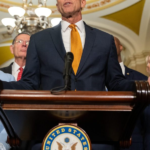Consumer prices rose in June at the level most economists expected, as the effects of President Donald Trump’s signature tariff policy began to worm their way through the economy.
In June prices rose 2.7% compared to the previous year, according to the Bureau of Labor Statistics’ monthly report released on Tuesday. That was an increase from the May number, which had seen inflation rise 2.4% over the previous 12 months.
“Core” inflation—the metric that excludes food and energy prices—rose 2.9%. The metric can serve as a more reliable indicator of price levels because the food and energy categories are sometimes particularly volatile.
Food and energy prices rose in 0.3% and 0.9% in the month of June. Both were increases from May when food prices rose 0.1% and energy costs had actually fallen 1% over the course of the month.
“While any tariff induced boost to inflation is likely to be short-lived, with higher tariffs being announced it would be wise for the Fed to remain on the sidelines for a few more months at least,” said Seema Shah, chief global strategist at Principal Asset Management.
Tariffs naturally consist of a price increase for any importer, as they must pay a duty on goods entering the U.S. But questions still remain on who will bear the cost of that price increase. Will importers succeed in foisting it on foreign suppliers? Will they pass the cost along to consumers? There’s also the fact that the tariff policies themselves remain mostly in flux. The exact rates that will be applied to individual countries and specific categories of goods—copper, automobile, pharmaceuticals—is not yet clear.
“Part of those tariffs will be absorbed by the importers, by the wholesalers, the transportation companies, advertisers, and retailers, with exact amounts also depending on the elasticities of demand for those products,” wrote William Blair U.S. macro analyst Richard de Chazal.
Many companies also front-loaded their inventories earlier this year to avoid tariffs they sensed were coming. Those stockpiles are only now starting to dwindle. Once they’re depleted, companies won’t have a choice but to purchase tariffed goods, inevitably raising their costs.
In Tuesday’s report, price levels for certain consumer essentials rose: Apparel prices were up 0.4% through June after having declined 0.4% the previous month. The household furnishings and operations category, which includes all the goods and services used for maintaining a home, such as furniture, appliances, cleaning products, and domestic services, rose 1.0% in June after being up 0.3% in May.
Prices for leisure activities also rose in June. The recreation index, which the BLS uses to track all prices for a basket of goods and services related to people’s hobbies and entertainment activities like television sets, expenses for pets, and tickets for live events, rose 0.4%.
The increase in those categories indicates “import levies are slowly filtering through to core goods prices,” Shah said.









